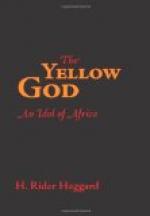“P.S. I ought to add with gratitude that even out of this hell fire I was enabled to snatch one brand from the burning, namely, the negro lad, Jeekie, to whose extraordinary resource and faithfulness I owe my escape. After a long hesitation I have been able to baptize him, although I fear that the taint of heathenism still clings to him. Thus not six months ago I caught him sacrificing a white cock to the image, Little Bonsa, in gratitude, as to my horror he explained, for my having been appointed an Honorary Canon of the Cathedral. I have told him to take that ugly mask which has been so often soaked in human blood, and melt it down over the kitchen stove, after picking out the gems in the eyes, that the proceeds may be given to the poor. Note. I had better see to this myself, as where Little Bonsa is concerned, Jeekie is not to be trusted. He says (with some excuse) that it has magic, and that if he melts it down, he will melt down too, and so shall I. How dark and ridiculous are the superstitions of the heathen! Perhaps, however, instead of destroying the thing, which is certainly unique, I might sell it to a museum, and thus spare the feelings of that weak vessel, Jeekie, who otherwise would very likely take it into his head to waste away and die, as these Africans do when their nerves are affected by terror of their fetish.”
CHAPTER VII
THE DIARY
Reflecting that time evidently had made little change in Jeekie, Alan studied this route map with care, and found that it started from Old Calabar, in the Bight of Biafra, on the west coast of Africa, whence it ran up to the Great Qua River, which it followed for a long way. Then it struck across country marked “dense forest,” northwards, and came to a river called Katsena, along the banks of which the route went eastwards. Thence it turned northward again through swamps, and ended in mountains called Shaku. In the middle of these mountains was written “Asiki People live here on Raaba River.”
The map was roughly drawn to scale, and Alan, who was an engineer accustomed to such things, easily calculated that the distance of this Raaba River from Old Calabar was about 350 miles as the crow flies, though probably the actual route to be travelled was nearer five hundred miles.
Having mastered the map, he opened the water-soaked diary. Turning page after page, only here and there could he make out a sentence, such as “so I defied that beautiful but terrific woman. I, a Christian minister, the husband of a heathen priestess! Perish the thought. Sooner would I be sacrificed to Bonsa.”
Then came more illegible pages and again a paragraph that could be read—“They gave me ‘The Bean’ in a gold cup, and knowing its deadly nature I prepared myself for death. But happily for me my stomach, always delicate, rejected it at once, though I felt queer for days afterwards. Whereon they clapped their hands and said I was evidently innocent and a great medicine man.”




